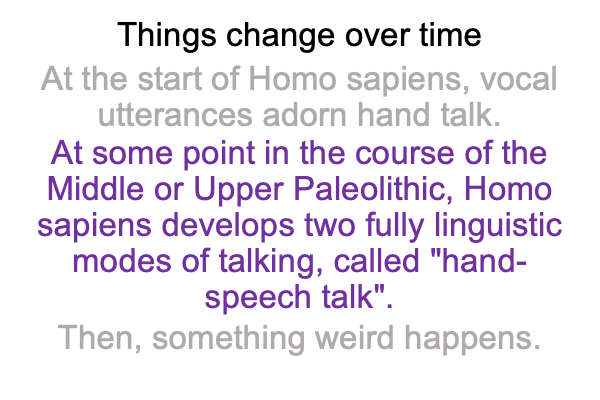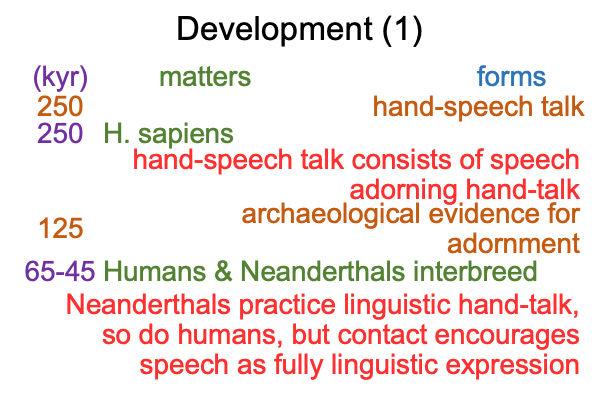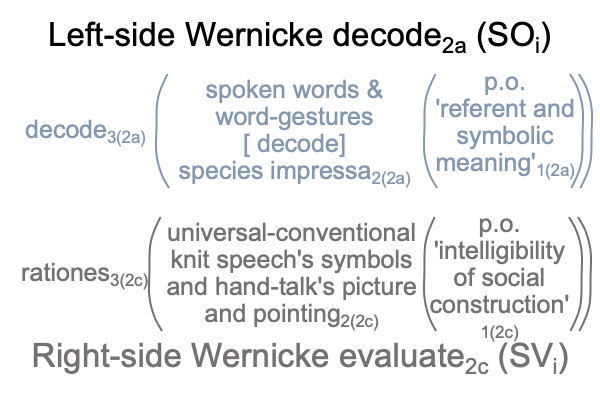0400 Steven Mithen does not explore the implications of synaesthesia with respect to what modern anthropologists regard as “symbols”. So-called “symbols” represent ‘something’, but modern anthropologists do not know what that something is.
Symbols may be artifacts, in the same way that hand-talk word-gestures are artifacts. To start, hand-talk words (and artifacts) image and point to their referents. So, the hand-talk word is sensibly specified. But, something like a vocal utterance, a spoken word, whose referent must be socially constructed, gets added in hand-speech talk.
The vocal utterance enters a cognitive space where its meaning, presence and message are specified (by its association with a hand-talk word). At the same time, the vocal utterance opens a cognitive space (as SOi) that bears witness to the utterer’s commitment2c (SVi).
Surely, this fits the nature of adornment.
0401 At the start, when speech serves as an adornment to hand-talk, the social construction is minimal. The vocal utterance is decoded as picturing and pointing to its referent. Indeed, this is the innate (or default) stance by Homo sapiens in regards to words (irrespective of mode). If a word exists, so must its referent. Plus, the word pictures and points to that referent. A referent precedes the word.
0402 The next step explores the cognitive spaces opened by adornment and… well… the possibility that hand-talk and speech-talk can be decoded independently.

0403 When Homo sapiens first appear in the archaeological record, they practice hand-speech talk. Spoken words adorn hand-talk word-gestures. Night-time talk is the motivation. But, soon enough, hand-speech talk is practiced in the day as well. As with body decorations, the modes of hand-speech talk are regulated by tribal traditions.
Why?
Speech is linked to synaesthesia and synaesthesia is tied to social construction.
0404 With these associations, I suppose that speech begins to take on a life of its own, not in the arena of sensible construction, but on the stage of social construction.
Nevertheless, even as cultural practices of adornment mount, hand-talk still characterizes species impressa2a. Sensible construction, typical for team activity, remains dominant, especially during the day.
0405 Here is a picture of the timeline of development.

0406 By 125 kyr, it is obvious that ochre is being used for something (such as body adornment) and sea shells (presumably attached to fiber strings) are found in campsites along with traces of fire. So, speech must be on the way to taking on a life of its own, after over one-hundred thousand years since the inception of the species.
Okay, the two-fully linguistic modes business takes time, without some “push”.
Humans enter ice-age Europe starting around 90kyr. Humans walk from Africa into Eurasia in waves, perhaps corresponding to climate transitions or improvements of Paleolithic technology.
0407 Genetic evidence leads to the conclusion that Neanderthals and humans interbreed, in Europe, between 65 and 45 kyr. Then, interbreeding stops.
Ah, the “push”.
My guess is that this period is when hand-talk and speech-talk take on lives of their own.
0408 When humans first contact Neanderthals, they both engage in fully linguistic hand-talk. However, the Neanderthal does not speak fluently, nor does the Neanderthal have interest in adornment. Neanderthal interest in adornment may well derive from exposure to human techniques and technologies. But, the speech aspect does not change significantly.
Of course, human cultures adapt to take advantage of Neanderthal limitations by increasing occasions for the use of speech.
Today, a business professor would call the process, “market differentiation”.
0409 But, speech is linked to synaesthesia and synaesthesia is tied to social construction.
A cultural shift in favor of speech as an independent mode of talking leads to an explosion in expressions of adornment2b, cross-modal species impressa2a, and um… can I say?… spiritual awareness2c?
In other words, interventional sign-objects (SOi) become more and more significant and, at the same time, awareness that there must be corresponding sign-vehicles (SVi) (or commitments2c) increases.
0410 In some respects, this is what Steven Mithen’s 1996 masterwork, The Prehistory of the Mind, is all about. He uses historical trends in the construction of cathedrals as a metaphor for the evolution of the human mind.
In the first period of hominin evolution, the open-nave cathedral (of general intelligence) flourishes. This period lasts from 7 to around 4 My.
In the second period of hominin evolution, the open-nave cathedral gives way to the Romanesque style of separate chapels (specialized mental modules associated with team activities) connected to a small central nave (of general intelligence). This period lasts from 4 to 0.6 Myr.
Then, in the third period of hominin evolution, the Romanesque style gives way to a Gothic architecture, where chapels (of specialized cognition) integrate into a soaring central nave (of language-enhanced general intelligence) that is supported by massive flying buttresses (of automated neural processing, like decode and evaluate). This period lasts from 0.6 Myr to 0.01 Myr.
0411 Yes, this period describes the Biblical intention (the appearance of Homo heidelbergensis), creation (the appearance of Homo sapiens) and blessing of humanity (the slow transition of hand-speech talk, from speech as adornment to speech as a fully linguistic modality) quite well.
Yes, synaesthesia and social construction have the potential to greatly enhance Mithen’s 1996 metaphors.
Once humans walk from Africa into Eurasia, the Neanderthal homeland, the Neanderthals cannot keep up with humans.
The human’s Gothic mental architecture develops in highly competitive ways. Cross-modal impressions2a support phantasms2b that are intelligible within multiple social circles. Speech develops as a separate mode of talk due to cultural natural selection.
0412 All the while, the bicameral (two-chambered) mind grows strong, pumping interventional sign-relations.
Here is a picture.

0413 The right-side Wernicke’s region is no longer simply assessing the iconicity and indexality of hand-talk gesture-words. It also introduces a vocal, synaesthetic and symbolic quality that enhances the intelligibility of the phantasm2b. The first evaluation supports the human’s commitment2c to sensible construction. The second contribution lifts the human’s commitment2c to social construction.
The left-side Wernicke’s region still automatically decodes hand-speech talk. Hand-talk and speech-adornment may be decoded simultaneously or independently. The independent decoding is particularly notable, given the production of evocative artifacts, such as the “lion man” from Hohlenstein-Stadel, Germany (estimated 41-35 kyr) or the female figurine from Dolni Vestonice in the Czech Republic (dating to 29-26 kyr, see page 28 in Mithen’s book, The Language Puzzle).
0414 Modern anthropologists call these artifacts, “symbols”, because they do not know what they represent.
Steven Mithen’s nyet hypothesis changes the question entirely.
The question now asks, “What are these artifacts speaking?”
